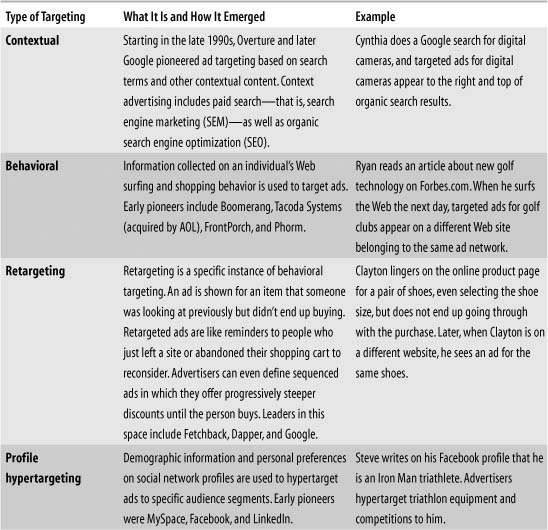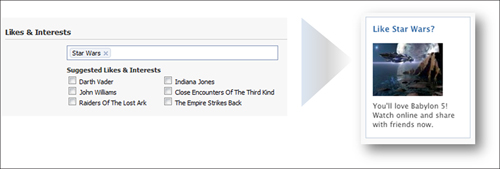12. How To: Advertise and Promote on the Social Web
As I introduced in Chapter 6, “Marketing in the Facebook Era,” marketers are now able to truly tailor the messages and experiences they provide for customers and prospects. Using the rich information on social network profiles, companies can make customer interactions more personalized and, thereby, improve relevance and conversions. Hypertargeting techniques can also tailor custom campaigns to make ads feel more relevant and personal to the people viewing them. Passive word-of-mouth broadcasts that occur across friend groups via Facebook News Feed further multiply the reach of these campaigns. This chapter walks through how to set up hypertargeted ad campaigns on Facebook and LinkedIn. It also touches on innovative new “engagement ad units” Facebook has been rolling out.
First, let’s talk about what you’re trying to accomplish. The ideal advertising campaign has 100% click-throughs and conversion. That’s what would happen if every ad was perfectly targeted with the right content to the right person at the right time. After all, if an ad is targeted and relevant, then it is valuable to both viewer and advertiser.
Of course, perfect targeting is not possible. But we are getting close. As you can see in Table 12.1, as more activity has moved online, advertisers have drastically increased their capability to target based on activity by and information about individuals. Before the Facebook Era, online advertising was largely behavior driven, based on explicit actions such as searching on a keyword or visiting a Web site. With social networking sites, we can layer on an important personal identity component about people who view ads so that we can target not only based on what people are doing, but also what they say and how they identify themselves.
Table 12.1 The Evolution of Ad Targeting
Building Your LinkedIn DirectAds Campaign
First, let’s walk through LinkedIn’s hypertargeted ad offering, DirectAds. LinkedIn’s advantage over Facebook is that it tends to have more career-related information about people, as well as more structured data (a taxonomy) about industries. The disadvantage is that noncareer-related information about people is quite lacking, so DirectAds generally is a better fit for B2B than B2C scenarios.
Building your LinkedIn campaign involves three steps: 1) create the ad, 2) target the ad, and 3) specify your payment model and budget. First, go to www.linkedin.com/directads/create.
Step 1: Create Your Ad.
Your ad consists of an image, a headline, body text, and a destination link.
• Image—You can choose any PNG, JPEG, or GIF image file. The optimal dimensions are 50 by 50 pixels. Although the image is important, LinkedIn will sometimes strips out the image for cost-per-click (CPC) ads and shows a text-only ad. If the image is crucial to your ad, choose the cost-per-thousand impressions (CPM) model in step 3 or work directly with LinkedIn on your ad placement.
• Headline—As with search ads, your headline is key in grabbing people’s attention (especially if your ad gets shown as text only). A good tip here is to choose a headline that relates to the target audience you define in step 2. For example, if you are targeting marketers, your headline might reference “The Perfect Tool for Marketers.”
• Body text—You have two lines to communicate the key benefit of your product or service and a call to action. Most often ads fail because the call to action is weak or nonexistent.
• Destination link—Just as you would for Google ads, create a custom URL so that you can track traffic and conversions back to this ad campaign.
Step 2: Select Targeting Criteria.
LinkedIn DirectAds allow hypertargeting on seven profile attributes: company size, job function, industry, seniority, gender, age, and geography:
• Company size—(See Figure 12.1.) This can be useful for prospecting to your ideal customer segments and is an example of data that Facebook does not have about employers. As in Facebook ads, the LinkedIn ad wizard dynamically updates the count of how many users match your criteria as you refine your targeting.
Figure 12.1
LinkedIn DirectAds allow hypertargeting based on the size of the company where someone is currently employed. Here you can see that more than two million LinkedIn members work at companies that have between 201 and 500 employees.
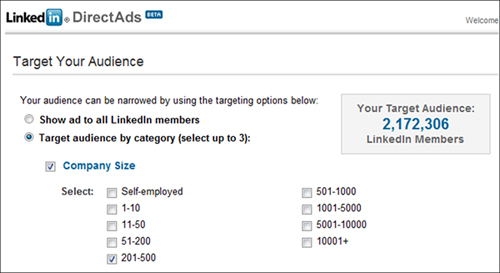
• Job function—(See Figure 12.2.) This can be useful for recruiting certain types of roles or to reach strategic decision makers in a sales cycle. You can select up to ten job functions from a structured list provided by LinkedIn. Facebook also lists job function, but it is free form rather than structured as it is here.
Figure 12.2
LinkedIn DirectAds allow hypertargeting based on someone’s current or past job function. You can target up to ten job functions per ad campaign.
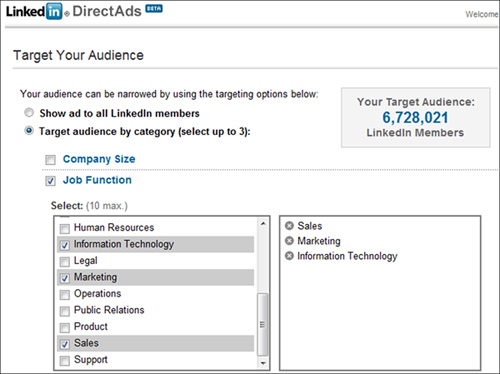
• Industry—Again, this can be useful for recruiting certain types of roles or to reach strategic decision makers in a sales cycle. You can select up to ten industries from a structured list provided by LinkedIn, and the targeting applies to both current and past industries. In comparison, Facebook does not have industry data on employers.
• Seniority—(See Figure 12.3.) This is another piece of useful information for recruiting certain types of roles or to reach strategic decision makers in a sales cycle. You can select from six different categories of seniority: individual contributor, manager, director, vice president, CXO, and owner.
Figure 12.3
LinkedIn DirectAds allow hypertargeting based on the someone’s seniority level. Here you can see that more than 2.3 million CXO level executives are on LinkedIn.
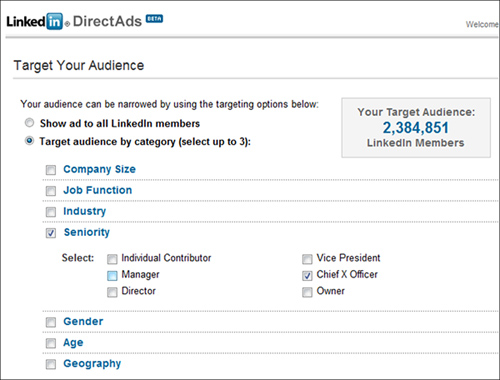
• Gender—This should be pretty self-explanatory. LinkedIn claims to have gender information for 70% of its members.
• Age—Again, this is pretty self-explanatory. LinkedIn has age information for fewer than 40% of its members, so this might not be a great targeting dimension to use if you want to maximize your reach.
• Geography—(See Figure 12.4.) Facebook allows targeting by country, state, or city and includes radius targeting. LinkedIn’s geography targeting is pretty limited, by comparison. There are only six countries to choose from, no state-level targeting, and city targeting only for select metro areas in the United States. LinkedIn’s largest audience is the United States, with more than 30 million members (more than half of all LinkedIn users). Next is India (nearly 5 million members) followed by the United Kingdom (3.7 million), Canada (2.2 million), the Netherlands (1.7 million), and Australia (1.1 million).
Figure 12.4
Because LinkedIn does not have a huge membership base outside the United States and a handful of countries, geography targeting for ads is limited to 6 countries and 40 U. S. metro areas.
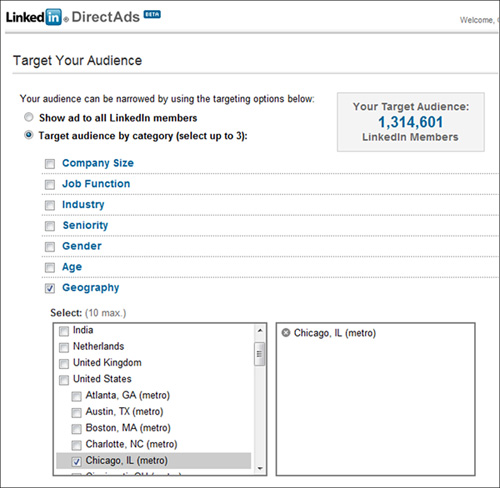
Step 3: Specify Your Budget.
As with Google AdWords, you can choose to pay per click (CPC) or per 1,000 impressions (CPM). The minimum bid is $2 for CPC and $3 for CPM, and the minimum daily budget is $10. You can run your campaign continuously as soon as it’s approved or specify an end date.
Many advertisers find CPC appealing because they are paying for performance only. When ads are not clicked on, the advertiser essentially gets a brand impression for free. On the other hand, CPM can deliver impressions more cheaply when click-throughs don’t matter. Without the pressure of having to generate a click, CPM ads might also tend to be flashier and contain more information.
What to Expect with LinkedIn Ads
Before you start your campaign, think about a few considerations unique to LinkedIn hypertargeted ads.
• You will notice less targeting on LinkedIn than on Facebook. For example, instead of defining your desired age bracket as you do with Facebook ads, LinkedIn lets you pick from four predefined age brackets.
• LinkedIn limits targeting on, at most, three of the seven criteria per campaign.
• You have the option to show ads on LinkedIn.com only or include LinkedIn’s ad network partners. The trade-off is achieving a greater reach versus knowing what to expect. This matters less if you opt for CPC pricing, because then you pay only for performance.
Depending on whether you choose to pay by CPC or CPM, your ad might appear in different places. Figure 12.5 shows both. CPC ads often appear as text-only link ads (with the image omitted) at the top of the LinkedIn home page or profile pages. They might be appended with a link in gray to the LinkedIn profile of the person or company that created the ad. (You can configure this under profile preferences.) Most CPM ads that appear in the middle of the home page or profile pages are custom Flash-based ads. I recommend contacting a LinkedIn ad sales rep for these.
Figure 12.5
This is a text-only CPC ad appearing at the top of the LinkedIn home page. After the ad text is a link to the LinkedIn profile of the individual who created the ad. On the right is a Flash-based CPM ad.
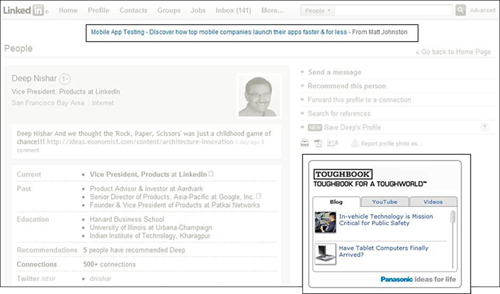
One aspect of LinkedIn DirectAds that many people find hard to get used to is that there is no keyword matching. Ads are shown only by targeting the audience attributes described earlier.
It’s early for social network ads in general, but especially so for LinkedIn ads. We ran nearly identical campaigns (to the extent possible, given the differences in the two ad systems) for the first edition of this book on both Facebook and LinkedIn. Facebook ads had more than twice as many click-throughs and conversions, and were a fraction of the cost. LinkedIn has an even bigger problem with a lack of purchase intent when people are on the site, as most people log in for the sole purpose of accepting or making a connection request, or searching for and viewing a specific set of profiles.
With the exception of recruiters, the companies I interviewed similarly struggled to see substantial results with LinkedIn ads—but if you have a success story, please share with me on whichever social network you prefer!
• Twitter—@clarashih #linkedin #ads
• Facebook—http://facebook.com/thefacebookera
• LinkedIn—www.linkedin.com/in/clarashih
Creating Your Facebook Ad Campaign
Facebook is an order of magnitude bigger than LinkedIn, so a lot more people might be interested in what your business has to offer. Of course, a lot more people also might not be a good fit for your products or services, so hypertargeting is even more important on Facebook.
Facebook has richer profile information about its members, which corresponds to more targeting criteria available to advertisers. Facebook lets you hypertarget against as many criteria as you’d like, which means you can define really narrow audiences to message to if that’s what you want to do.
To get started, go to http://facebook.com/ads.
Step 1: Create Your Ad.
Similar to LinkedIn ads, Facebook ads consist of an image, a headline, body text, and a destination link.
Based on the audience you have identified and will target in step 2, customize your ad copy to appeal to the unique needs and preferences of that audience. What’s important to this particular segment? What do you know about them (that is, what have you selected for) that you can use to make the message more personal? What have they bought in the past? What are they likely to want to buy in the future? Keep the ad text simple and be specific. Avoid compound sentences. Use simple language and good grammar. Especially if your objective is brand recognition, you should include your company or product name in the ad title or body.
As in any ad, the most important step is to provide a compelling call-to-action that encourages users to click on your ad. Users should clearly see in your ad copy exactly what you expect them to do and how they will benefit from going to your landing page. Use strong action-oriented phrases such as buy, sell, see, order, register, and win. Improve customer engagement and likeliness to click by making messages feel more personal and meant for them specifically.
Uploading an image is optional but highly recommended. Facebook’s data shows that ads with an image perform much better than ads without one. The optimal image size is 110 pixels wide by 80 pixels tall, so you create or resize your ad image accordingly. Without special consideration, text in images, in particular, can sometimes become distorted and hard to read.
Step 2: Hypertarget Your Ad.
When you have your ad, you can target your audience along 11 different profile dimensions:
• Location—(See Figure 12.6.) Facebook lets you target by country, state, or city. Each ad can target up to 25 countries at a time. A powerful tool for local businesses such as restaurants, spas, and insurance agents is radius targeting, which shows ads to everyone within 10, 25, or 50 miles of a city. Behind the scenes, Facebook does the targeting based on the user’s IP address and address, if the user has entered them.
Figure 12.6
Location targeting on Facebook ads enables you to specify country, state, and/or city, as well as surrounding areas within a certain radius of a city.
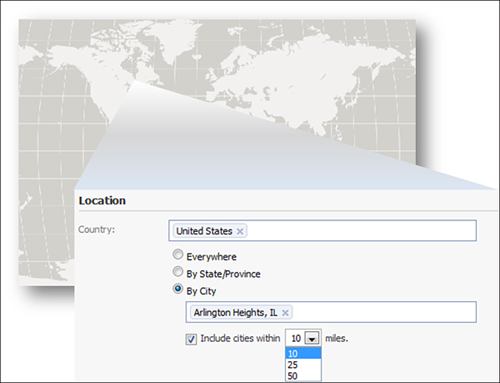
• Age—You can specify an age range to target, from 13 (the minimum age to join Facebook) to 64. If you don’t specify an age range, Facebook targets all users 18 and older. The college and recent graduate group is still the largest demographic on Facebook (29% of users), but older folks are catching up. More than half of Facebook users have been out of college for four or more years, and the fastest-growing demographic on Facebook is 35–49. Note that you can also choose to target people on their birthdays here, which a lot of businesses have found to be pretty effective—who doesn’t appreciate a special wish or free gift on their birthday? More than a million birthdays pop up each day on Facebook!
• Gender—Nearly 95% of Facebook users have specified their gender, so this is a fairly reliable hypertargeting dimension. The U. S. Facebook population skews slightly female (55%). The optimal ad copy and image you select for your campaigns might differ greatly based on gender even if you are selling the same product. Gender is especially important in retail ads. If your product is meant for a specific gender, such as women, you might want to consider using two ad segments: ads appealing to women about your product and ads targeting men that talk about your product as a great gift for women. Figure 12.7 is an example of a gender-specific ad.
Figure 12.7
This ad is applicable only to males (perhaps in a certain age range).

Reprinted by permission
• Gender interest—The combination of gender and gender interest allows targeting for sexual orientation. This is a popular hypertargeting dimension for dating sites and media sites with content about relationships and dating. Groups and services targeting the lesbian, gay, bisexual, and transgender (LGBT) community can reach this audience by selecting the same gender in both the Sex and Relationship Interest fields.
• Relationship status—Relationship status, together with age and education level, is a good indicator of “stage of life.” This is commonly used by dating services (targeting people who are single), jewelry companies (targeting people in a relationship, as in Figure 12.8), and the wedding industry (targeting people who are engaged).
Relationship status is also highly correlated with lifestyle, and certain lifestyles might be more amenable to your product or service. For example, a married person might be more likely than a single person to be interested in ads about purchasing life insurance or buying a home.
Figure 12.8
An ad like this would likely be shown to a male who has specified that he is in a relationship but not yet engaged or married. (No pressure, guys!)
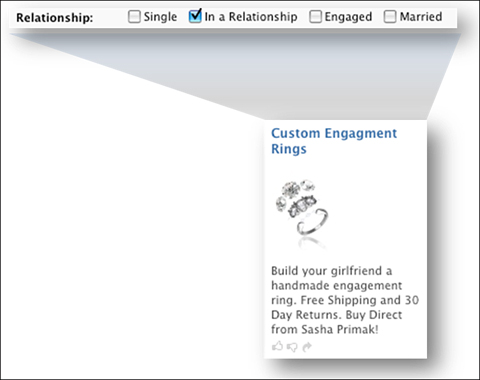
Reprinted by permission
• Languages—Language targeting is extremely powerful for any multicultural initiatives your company might want to do. For example, you might want to run a custom campaign in Spanish for Spanish-language users in the United States. This is an important tool for media companies and agencies working on behalf of language-specific brands or subbrands.
• Likes and interests (keywords)—Keyword targeting is probably the most important hypertargeting dimension because it encompasses most of what’s on a profile, including favorite movies, books, and music, groups and Pages they have connected to, religion, political views, and job title. A popular tactic is for advertisers to target based on competitors’ brands or related products and services, as shown in Figure 12.9.
Figure 12.9
This ad for an American science fiction TV series targets Star Wars fans.
• Education level and school—Here’s another stage-of-life proxy. Tip: Once you choose to target “In College” or “College Grads,” Facebook gives an option to target by major and graduation year as well. This dimension is ideal for college recruiters, tutors, GMAT test prep services, and similar services. Alumni associations can also use this feature to reach former students who have graduated.
• Workplace—Workplace targeting enables you to reach employees in specific company networks and is most similar to the targeting on LinkedIn DirectAds. Unlike LinkedIn, however, there is no metadata on companies such as company size and industry—you have to manually enter company names. This is ideal for B2B sales and recruiting.
• Connections—This is an easy way to target existing fans, attendees, members, and users of your Facebook Page, Event, Group, or application. You can also choose to specifically target people who aren’t fans, attendees, members, or users. I used connection targeting to promote this book to people who use my Faceconnector application and aren’t already fans of the book, as shown in Figure 12.10. This resulted in much better conversions than my other ad campaigns because this group of individuals is highly qualified—these people are interested in using Facebook for business and trust me enough to use my application.
Figure 12.10
To reach a highly qualified group of individuals with ads for my book, I targeted people who had installed or were fans of the Faceconnector application I developed but who hadn’t yet “liked” my book’s Facebook Page.

• Friends of connection—Another great way to take advantage of connection targeting is to show ads to friends of fans, attendees, members, and users of your Facebook Page, Event, Group, or application. As shown in Figure 12.11, people viewing the ad will see which of their friends are already connected with your Page, Event, Group, or application, and the transitive trust and word-of-mouth concepts we discussed in Chapter 6 will hopefully kick in.
Figure 12.11
Friend-of-connection targeting yields social ads such as this one and can help companies build more immediate credibility by tapping into trust and social capital between friends. Because Chris likes my book and Chris’s friends trust Chris, they are more likely to be transitively interested in my book. Recommendations and referrals from friends are the most powerful influencer of purchase decisions.
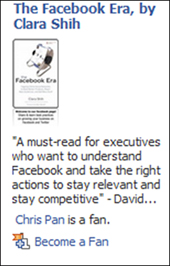
Step 3: Specify Your Budget.
As with search ads and LinkedIn DirectAds, you can choose to pay per click (CPC) or pay per 1,000 impressions (CPM). The minimum bid is 1¢ for CPC and 2¢ for CPM, and the minimum daily budget is $1, costs that are a lot lower than on LinkedIn. You can run your campaign continuously as soon as it’s approved or specify both start and end dates and times.
I really like the Facebook ad tool because it takes a lot of the guesswork out of creating your campaign. Not only does it show a suggested bid range, but Facebook also lets you know roughly how many impressions or clicks you should expect per day based on the bid entered.
What to Expect with Facebook Ads
Facebook ads tend to have low click-through rate compared to AdWords, but higher conversions (see Table 12.2). A few reasons likely account for this:
• Lack of purchase intent—Search marketing is so effective because ads are targeted to people at the moment they are looking to buy something. On Facebook, people are generally in a different mindset. Most often they are browsing pictures and news about friends, or playing games. So Facebook ads are less about clicks today and more about seeding interest for tomorrow. Companies have a good opportunity to reach likely buyers earlier in the purchasing cycle.
• A lot of ad inventory—Facebook is the most highly trafficked Web site in the world, even beating Google. The huge number of page views creates a lot of ad inventory, which drives down click-through rates. But this isn’t necessarily a bad thing, because price gets driven down at the same time.
• People hate leaving Facebook—The numbers are very telling. People spend an average of an hour per day on Facebook. More than half of those under age 30 are on Facebook more than 90% of the time they are online. Not surprisingly, ads that drive people to Pages, applications, groups, and events on Facebook benefit from a much higher click-through rate than ads that drive people to an external Web site.
Table 12.2 Comparing Average Performance for Different Ad Types

Sources: Marketing Today, Emarket2, and test campaigns
For the most part, people don’t really search for products and services on Facebook, although this could change as the Facebook application ecosystem grows or if Facebook decides to create an ad network out of Facebook for Websites partners. Without clear purchase intent on Facebook, it’s unfair to compare Facebook ads to search marketing. Compared to traditional banner advertising, Facebook is as good or better.
Note that Table 12.2 is a gross generalization of performance across different channels. Both click-through rate (CTR) and conversions are highly dependent on industry, brand equity, ad copy and placement, and offer or call to action. The goal of showing these high-level numbers is to highlight the very different nature of social network ads.
For example, Twitter could theoretically yield higher than 100% CTR if you get retweeted, which would basically never happen with AdWords. On Facebook, certain ads also are shown repeatedly to the same individuals, even if they have already clicked on the ad (and, for all we know, performed the call to action). This is especially likely to happen if you set the hypertargeting criteria so narrowly that only a small number of audience members qualify to view the ad. In this case, click-through rate and conversion per person might be really high, but because there are a large number of impressions shown to each person, the click-through per impression appears low.
We already talked about how CTR goes up when a Facebook ad points to something on Facebook instead of an external site because people hate leaving Facebook. For some businesses, it makes sense to count new fans, comments, and “likes” as conversions instead of trying to force traditional offers and email signups as the call to action.
Most people just don’t have very much experience with hypertargeted or social ads. We talked earlier about how ads optimized for search marketing aren’t generally optimal for social networks. One reason for poor performance could just be that we aren’t yet good at social network advertising. But if you elect to pay per click, who cares about low CTR? You are just getting extra impressions for free. As marketers, we are still getting used to all of these nuances.
For additional help, we can get some advice on optimizing Facebook ads from the guy at Facebook who is in charge of them. In the following guest expert sidebar, Tim Kendall of Facebook shares a few tips for advertising on the social Web.
Four Tips for Successful Facebook Ad Campaigns
Tim Kendall
Facebook ads let you reach your exact audience and connect real customers to your business. Here are a few tips on how to optimize your campaigns, based on our experience working with advertisers across different industries and geographies:
• Target people precisely. Reach people predisposed to your product or service by selecting relevant targeting parameters. Selling trendy, high-end handbags in New York? Target your Facebook ad to women in New York between the ages of 25 and 45 who are interested in “fashion” and like “handbags. As you develop your target group, Facebook autosuggests up to three additional parameters that are most common among the group of people you have already selected in the targeting tool. Adding these suggestions to your target set will increase the size of your ad’s potential audience while ensuring that you still reach people with relevant interests.
• Speak to each one of your customers. Test a variety of images, experiment with different calls to action, and consider varying the creative based on the group of people you are targeting. The most effective salespeople often tailor their message based on the client’s background, profile, and motivations. If you would describe your product or service differently to a female, twenty-something college student than you would to a forty-something male professional, develop specific creative that maps to each customer segment you intend to target.
• Engage the user. Facebook ads allow people to engage with ads in the same way they interact with other content on the site and without leaving the page they’re viewing. For example, potential customers can directly engage with your business by clicking on the Like This Page link or the RSVP to This Event link. This lightweight and common action automatically posts to the person’s profile page and on their friends’home page, generating additional (and free) distribution.
• Make it social. People use Facebook to learn about their world through the lens of their friends. So it doesn’t surprise us that ads with information about people’s friends perform up to 50% better in terms of CTR, conversion rate, and BrandLift (a Nielsen offering that gauges ad effectiveness—we talk about this later in this chapter). Adding this friend information (or “social context) to your Facebook ads is simple. First, promote your page or event to build a base of people who “like” your page or RSVP to your event. Second, leverage “friends-of-connection” targeting to develop an ad campaign that targets the friends of people who “like” your page or have RSVP’d to your event. This ensures that every ad you run will include social context because you are constraining your campaign footprint to only the friends of the people who “like” your page or have RSVP’d to your event.
Tim Kendall (@tkendall) is the director of monetization at Facebook.
Which Attributes Should You Hypertarget On?
The hardest but most important aspect of Facebook ads is choosing the optimal attributes to target. The number of possible attribute combinations can be overwhelming for new advertisers. You select a particular attribute for two reasons:
1. Your product has no relevance to people who have a certain attribute. For example, an ad for women’s shoes should generally be hypertargeted at females only. Unlike other items a woman might own (like jewelry or lingerie), shoes are not generally something that males purchase for women, so you would not be losing reach to likely buyers. You are simply not wasting ads on a group of people (men) who are not likely to be interested in your product. Women’s shoes are not relevant to people whose gender is male.
2. The way you message the same product differs greatly depending on this attribute. For example, a heterosexual dating site might want to advertise to both men and women, but the ideal ad shown to males would differ greatly from the ideal ad shown to females.
It’s easy to get carried away and overtarget. We have to weigh the extra hassle of creating a greater number of more narrowly focused campaigns against the benefits of higher CTR and conversion.
The trick is to find a small number of criteria that matter most about your product. These criteria vary by product. For example, relationship status (“engaged”) and gender (“female”) might be most important in ads for wedding planning services, but they have no bearing on ads for digital cameras. Over time, as you discover more about the audiences interested in your product, your targeting effectiveness should improve.
I always recommend starting a campaign with a broader audience and then honing in on narrower segments as you gain more insights from the ad analytics into what profiles of people are clicking the most. I learned this lesson firsthand when marketing the first edition of this book. Originally, I thought this book would appeal mainly to business professionals in sales and marketing, so those were the profiles we targeted. As an experiment one time, we decided to remove all the targeting criteria for one of our campaigns and were pleasantly surprised to discover that, besides our expected audience, there was also strong demand from the nonprofit and academic business school markets for this book. Once we discovered these new segments, we subsequently created different campaigns and bid different CPCs based on the combination of Facebook’s suggested bid and our expected CTR for that particular segment. Specifically, my CPC for sales professionals has been an average of 79¢, and my CPC for the business school audience has been 61¢. Creating separate campaigns for each allows me to both tailor my message (which improves CTR and conversion) and avoid overbidding for the business school audience.
In traditional marketing, we likely might not ever have had the opportunity to challenge our prematurely drawn conclusions about which audience would be interested in this book. With Facebook, we have found two immense markets that I almost overlooked! (And by the way, it’s thanks to Facebook that this edition of the book has a new chapter dedicated to nonprofits and political campaigns!) The ad analytics Facebook provides are a treasure trove of market insights—you might be surprised (as I was) by what you didn’t know about your customers and prospects.
Selecting Your Ad Creative and Call to Action
The biggest distinction about Facebook ads is that instead of driving clicks to an external landing page, you can send people to your Page, application, group, or event on Facebook—and often it is better to do so. People don’t like to leave the Facebook environment, so linking back within the same environment generally increases click-through rates.
Using the Static FBML application described in the previous chapter, you can create and link to a custom landing tab on your Facebook Page, as I did for this book’s Facebook Page (see Figure 12.12). Static FBML lets you embed images, Flash, video, buttons, forms, and other HTML elements on your custom tab so that you can create a compelling experience and call to action in the split-second you have someone’s attention after they click on an ad. Besides driving ad clicks to custom tabs, you can also specify the default tab for when anyone visits your Page. (Do this under Page Settings.)
Figure 12.12
This is a custom landing tab with clear calls to action from this book’s Facebook Page, at http://facebook.com/thefacebookera. Using Facebook Markup Language (FBML), you can code it so that different calls to action appear to people based on whether they have “liked” your Page.
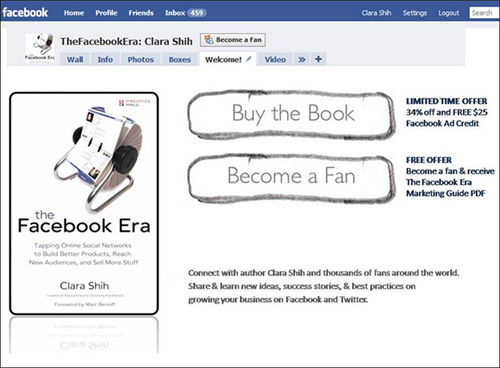
As you get more sophisticated, you can even create multiple landing tabs for multiple campaigns to try new things, compare performance, or tailor to different audiences.
As for ad copy, don’t just tell people to “like” Your Facebook Page. Tell them why they should. Give them a great offer, such as a discount, a free sample, or even helpful information. Better yet, provide incentives for people to share your offer with friends, as companies such as Groupon are doing. Some companies have found it effective to target ads at existing fans to improve engagement, build loyalty, and encourage sharing.
For your first few campaigns, start small. Tweak and test your campaigns with different hypertargeting criteria and values. Compare your cost-to-performance ratios for CPM versus CPC. Be creative. Try different messages. Run ads for two weeks, and then assess their effectiveness. What was the click-through rate? What was the conversion into sales? Which hypersegments performed the best? Learn from your tests and keep trying new things.
Tying Back to Your Goals
Of course, anything you do should be tied back to your social networking strategy developed in Chapter 8, “Recruiting in the Facebook Era.” Work backward from your goals. Is your primary focus new customer acquisition? Or do you have plenty of customers but need to up-sell and cross-sell them on new products? Here are some goals for which hypertargeting works particularly well:
• Reach new audience segments, such as a new age group, region, interests, or college attended.
• Test new messages and see what resonates.
• Think globally, act locally—similar to how Bonobos, Inc., has global sales and operations but tailors its campaigns to each school and hometown sports team fans to make its products feel more personal and relevant.
• Up-sell or cross-sell existing customers on additional products and services.
• Learn about your customer base and what factors most heavily influence interest and purchase decisions.
If your campaigns aren’t performing to your expectations, try using different copy or altering your hypertargeting strategy. Table 12.3 highlights common issues advertisers face with hypertargeting and offers suggested ways to address them.
Table 12.3 Common Issues with Hypertargeted Ad Campaigns and Suggestions on How to Resolve Them
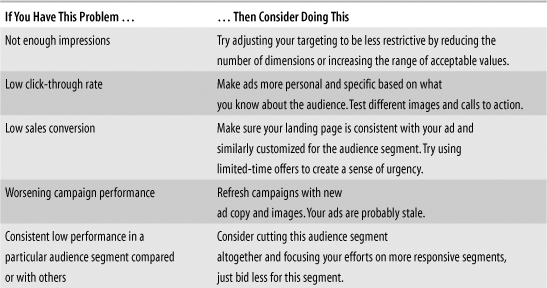
In the following guest expert sidebar, entrepreneur Auren Hoffman shares additional tips on how to run a social marketing campaign.
How to Run a Social Marketing Campaign
Auren Hoffman
Running a social media campaign has become a right of passage for every major marketer at large brands, retailers, banks, airlines, hotels, nonprofits, and more. Consider these six tips on what to do and what not to do:
• Do tie in email marketing. Email is the most important communication medium. I’ll say that again:There is no more important communication medium than email—there’s not even a close second. Until you do a great job on email, it’s not worth investing in social campaigns.
Every one of your customers has an email account, and most of them read their email ten times per day (or more). When you have email working and churning, you can drive people to Facebook, Twitter, YouTube videos, and more. Do this by creating short, targeted emails that people respond to and that they forward to others.
• Don’t expect immediate results. Great social marketing campaigns take time. This is not the job of a single person: Successful campaigns require efforts by all departments. Try different things and experiment—successful campaigns require lots of iterations.
• Do track and measure responses. Data is the only way to know how effective campaigns are. Make sure you track clicks, opens, retweets, growth of fans, coupon codes redeemed, number of mentions, and more.
• Don’t treat everyone the same. Make sure you identify your influencers and then make sure you reward them. Give influencers higher-priority customer service, special promotions, and exclusive invitations. Set up systems to automatically flag these special accounts.
• Do get as much customer data as possible. Supplement gaps in knowledge by asking for user information or using third-party data services. Learning about customer demographics, interests, social network behavior, and more can help you increase campaign effectiveness.
• Don’t hesitate to engage me. I look forward to continuing the conversation: http://blog.summation.net.
Auren Hoffman (@auren) is CEO of Rapleaf.
Engagement Ads
In addition to click ads, Facebook is exploring what it calls engagement ads. Engagement ads were designed to offer advertisers minimally invasive ways of inserting their brands into everyday Facebook interactions. The thought is that if there are opportunities for people to engage with brands without disrupting their primary mission on social networking sites—that is, expressing themselves and socializing with others—then they will be much more likely to take advantage of these opportunities. Targeted ads, in contrast, are disruptive in the Facebook member’s experience. Clicking on an ad drives users away from what they were previously doing without giving them a chance to socially engage.
Facebook has developed several models of incorporating advertising into social behavior that people are already doing on Facebook. These are innovative social ad units for people on Facebook to comment on videos, send sponsored virtual gifts, “like” your Page, RSVP for events, request free samples, and respond to polls without having to leave the Web page they are on.
Video commenting combines the viral nature of entertaining videos popularized by YouTube with the friend graph and feed stories (see Figure 12.13). For example, MTV purchased a video ad on Facebook of Britney Spears opening the Video Music Awards. Users could view and comment on the video completely in-line, without clicking to another page. This generated awareness and participation while offering members an opportunity to engage with friends.
Figure 12.13
Video commenting ads are ideal for promoting popular media such as music videos, movie trailers, and TV shows. They encourage viral marketing by offering people a way to react and engage with their friends on the video.
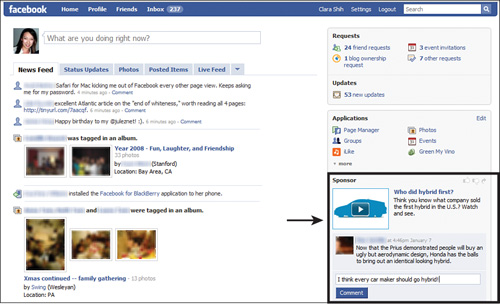
Sponsored virtual gifts are a second engagement ad model. Virtual gifts have become a popular way for Facebook users to exchange social capital, express affection, and build rapport, such as for birthdays, special achievements, and other milestones. Brands now have the opportunity to sponsor virtual gifts so that instead of costing the sender $1, they are free. The brand benefits not only from the sender and recipient engaging with the brand, but also from the resulting social feed stories that get propagated to both sender and recipient’s networks. For example, Wendy’s, a popular fast-food restaurant, sponsored a branded virtual gift to spread the word about its new “flavor dipped” sandwiches (see Figure 12.14). Sponsored virtual gifts can be a fun, visual, and memorable form of word-of-mouth awareness for your product or brand.
Figure 12.14
Wendy’s, a fast-food chain, sponsored a virtual gift to virally spread the word about its new line of “flavor dipped” sandwiches.
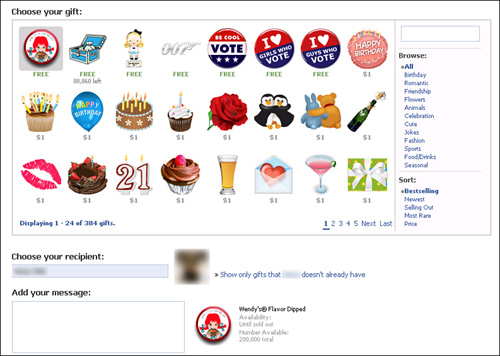
Facebook also offers polls that not only engage users but can also collect valuable audience data for advertisers. For certain polls, Facebook has partnered with Nielsen on a new tool called Brand Lift, which helps measure the impact of branded advertising on Facebook. The idea is that a large number of polls are used to measure audience sentiment and purchase intent (see Figure 12.15). Half the polls are shown to users who have been shown a particular ad. The other half of the polls are shown to users who have not been shown a particular ad but have otherwise identical profile attributes. The logic is that any substantive differences in purchase intent can be attributed to the advertising campaign. Currently, this tool is available only to existing Nielsen customers.
For consumer packaged goods and food and beverage products, Facebook is also offering “engagement sampling ads,” which allow advertisers to make free physical samples available to certain audiences on Facebook (see Figure 12.16). Audience members see the sampling ad on their home screen and can enter their address to receive the free product sample. With this initiative, Facebook is starting to collect the physical mailing addresses of its users, although it’s important to note that advertisers have rights to the address information for the purpose of mailing samples only, not to use or resell them as a list after the campaign.
Figure 12.15
Polls have been a great way for advertisers on Facebook to not only engage audiences, but also collect valuable data. Polls such as this one are part of Facebook and Nielsen’s new Brand Lift initiative, which aims to measure the impact of branded ad campaigns on Facebook.
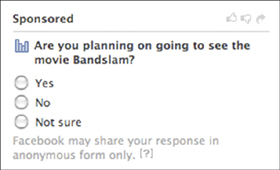
Figure 12.16
Facebook recently launched engagement sampling ads that allow advertisers to make free physical samples of their products available to Facebook users. For example, this sampling ad for Texas Pete hot sauce generated 5,000 signups for samples in two days.
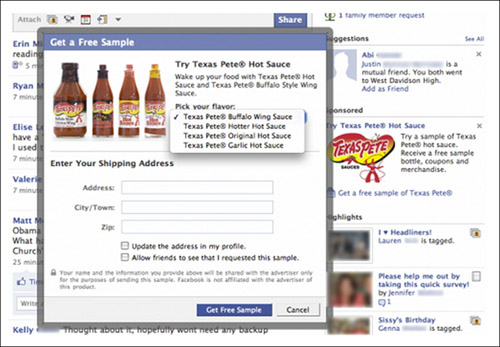
The remaining engagement ad types are the in-line event RSVP and “likes” for your Page. The rationale for these is that people are much more likely to participate if it’s easy for them to do so. Being able to RSVP or “like” a Page in-line without clicking to another page minimizes the amount of effort required by the user to engage (see Figures 12.17 and 12.18).
Figure 12.17
Engagement ads on Facebook allow users to “like” a Facebook Page with one click, without leaving the page they’re on.
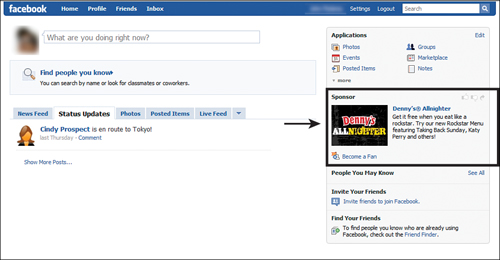
Figure 12.18
Engagement ads on Facebook also allow users to RSVP and leave notes for advertiser-sponsored events in-line without leaving the page they’re on.
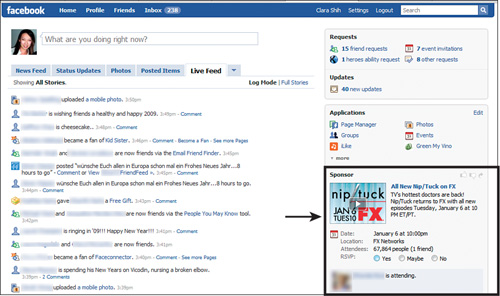
Engagement ads are geared more toward brand advertisers with deeper pockets. Home page campaigns start at $50,000. Unlike Facebook ads, which can be purchased self-service with a credit card, engagement ads require going through the Facebook ad sales team at www.facebook.com/business/contact.php.
Twitter’s Promoted Tweets
Advertising on Twitter is quite different from advertising on either Facebook or LinkedIn. Twitter recently launched “promoted tweets,” a form of search advertising that allows businesses and organizations to pay for placement at the top of Twitter search results (shown in Figure 12.19). Promoted tweets are can be @replied to, retweeted, and favorited just like regular tweets, which can help companies tap into the social sharing and engagements aspects of Twitter. This is a relatively new feature, so there aren’t yet great stats on the effectiveness of promoted tweets.
Figure 12.19
Promoted tweets on Twitter are paid corporate messages that appear at the top of search results.
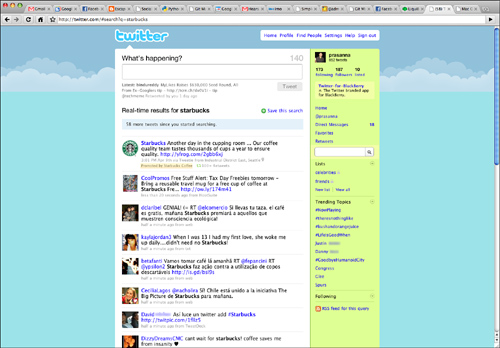
![]() Regardless of whether you want to advertise on Facebook or LinkedIn, you can use their free ad targeting tools to determine whether your target audience is on those sites. As you update your ad targeting criteria, both Facebook and LinkedIn’s ad creation wizard updates in real time the approximate number of audience members that fit the criteria you have specified.
Regardless of whether you want to advertise on Facebook or LinkedIn, you can use their free ad targeting tools to determine whether your target audience is on those sites. As you update your ad targeting criteria, both Facebook and LinkedIn’s ad creation wizard updates in real time the approximate number of audience members that fit the criteria you have specified.
![]() Because LinkedIn has more career information and industry metadata, LinkedIn DirectAds might be a better fit for B2B companies and recruiters who want to advertise.
Because LinkedIn has more career information and industry metadata, LinkedIn DirectAds might be a better fit for B2B companies and recruiters who want to advertise.
![]() Be careful with CPC ads on LinkedIn. Often the image you uploaded isn’t shown because LinkedIn displays your ad in the text-only slot at the top center of the home page and profile pages.
Be careful with CPC ads on LinkedIn. Often the image you uploaded isn’t shown because LinkedIn displays your ad in the text-only slot at the top center of the home page and profile pages.
![]() Facebook offers 11 targeting dimensions, including age, location, gender, gender interest, relationship status and interest, likes, school, employer, and connections. LinkedIn has seven, including company size, job function, industry, seniority, gender, age, and geography.
Facebook offers 11 targeting dimensions, including age, location, gender, gender interest, relationship status and interest, likes, school, employer, and connections. LinkedIn has seven, including company size, job function, industry, seniority, gender, age, and geography.
![]() Facebook ads are most similar to traditional online banner ads, but they perform better. Compared to search ads, Facebook ads tend to have lower CTR but higher landing page conversions.
Facebook ads are most similar to traditional online banner ads, but they perform better. Compared to search ads, Facebook ads tend to have lower CTR but higher landing page conversions.
> > > TIPS and TO DO’s
![]() Start your campaigns with a broader audience and slowly increase your hypertargeting criteria as you learn more about which segments are clicking through and converting.
Start your campaigns with a broader audience and slowly increase your hypertargeting criteria as you learn more about which segments are clicking through and converting.
![]() Consider driving Facebook ads to a landing tab on your Facebook Page.
Consider driving Facebook ads to a landing tab on your Facebook Page.
![]() Create a clear call to action for your ads.
Create a clear call to action for your ads.
![]() Don’t just tell people to “like” your Page; tell them why they should “like” it.
Don’t just tell people to “like” your Page; tell them why they should “like” it.
![]() Try and test new things with your LinkedIn and Facebook ad campaigns, to find the right formula that works for your product and audience.
Try and test new things with your LinkedIn and Facebook ad campaigns, to find the right formula that works for your product and audience.

